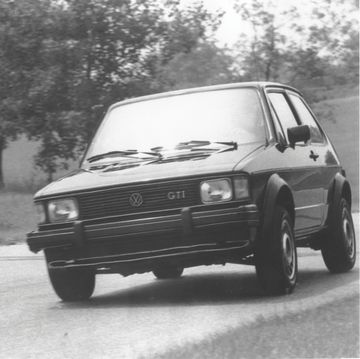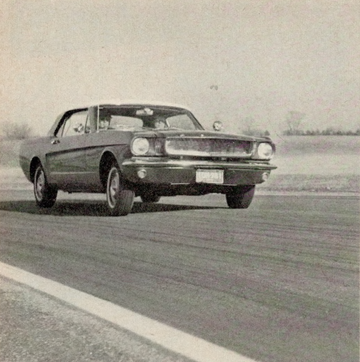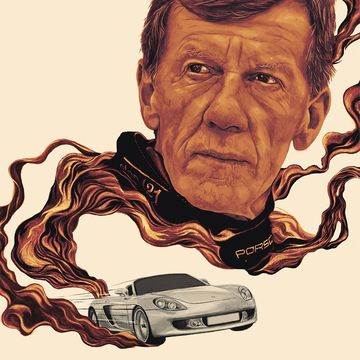The most powerful scene in Martin Scorcese's "Casino" has nothing to do with violence or sex or even money. It's in the final moments of the film. After nearly three hours of sustained glamour—neon lights, high rollers, gorgeous working girls, and a succession of increasingly well-optioned Cadillac Eldorados—the camera shows a crowd of "real" people walking through the doors of a modern corporate casino. It's a flood of velvet track suits and frumpy jeans and bad haircuts.
The message is plain: the glamor is long gone. What was once a playground for playboys has become a pigpen full of penny slots and bad buffet food. The risk, the danger, the sexiness; it's all disappeared, replaced by a bland corporate dedication to middle-class entertainment. Who could get excited about something like that?
About forty-two years ago, auto writer Brock Yates and racing icon Dan Gurney hopped in a Ferrari Daytona coupe and blasted across the country, leading a group of high-glamour scofflaws. The purpose? They said it was to display the something-something about the whatever about the double-nickel speed limit. Nobody bought it.
The purpose was to do something magnificent and brash and fun.
The Cannonball Run was full of characters: the inexplicably wealthy, the frighteningly talented, the frankly insane. It was such a great thing, such a great story, that Hal Needham turned it into a movie. Twice.
Yesterday, a guy from some Lamborghini dealership announced that he'd broken the "record" for cross-country speeding. He's far from the first to have reset the bar since Yates and Gurney did it. Most notably, Manhattan socialite and author Alex Roy employed a staggering array of technological assistance and original thinking to set the mark six years ago.
Where Yates and Gurney displayed devil-may-care savoir faire, Roy countered with computer-driven mapping and high-speed aircraft above his route. But the charmlessness of his approach was at least partially balanced by Roy himself—a raconteur, party boy, impersonator of police across multiple continents, and engaging writer. He wasn't as cool as Dan Gurney, but he was doing his own thing, and you had to respect that, even if you thought that the whole notion of a "cross-country" record represented a unique mix of stupidity, callousness, and willingness to risk the lives of innocents along the way.
Now we have Ed, the current claimant to the record. Dan Gurney had a thousand races under his belt. Alex Roy had a white Hermes scarf and a story about surviving September 11th on the streets of New York. Ed had a bedpan.
That's right: the secret to the latest breaking of the record revolves around Ed and his partners' ability to relieve themselves while driving. They lashed up a pair of fuel tanks in the trunk of their old Mercedes CL, using a metal strap that wouldn't pass tech at the 24 Hours of Lemons. The car, we are told, stank of gas for the entire trip. So it boils down to this: For twenty-eight hours they endangered women, children, truck drivers, and various roadside animal life in a rolling bomb that probably smelled like an unmaintained gas-station bathroom.
While it can be argued that there are limited situations in which using a bedpan on the move can be cool—sailing around the world alone, flying rescue missions in a Coast Guard helicopter, low earth orbit—this certainly isn't one of them. If the early reports of the "mission" can be believed, they didn't even drive that quickly. They just didn't stop very much.
Which, of course, means that the record can be easily broken by doing the same thing, only more so. Four gas tanks in a CL55, or three fuel tanks in an E300 turbodiesel. A Prius with stiff springs and a few fifty-five-gallon bladders. A GMC motorhome with a twin-turbocharged 455 and a series of fuel tankers along the road for in-flight refills. Actually, that last idea would be kind of cool. Regardless of the precise method used, from now on this so-called record will be an exercise in poop-and-drive, perhaps combined with increasingly inventive strategies for adding fuel tanks to trunks.
One wonders what would have happened had Ed lost control of the car and hit a minivan full of people. It would have been: boom, flash, bang, with any survivors soaked in urine from the mobile toilet facilities. What excuses could anyone involved have possibly made? "We wanted to reset a mostly imaginary record, so we loaded the car up with leaky fuel tanks and drove it at one hundred miles per hour into your minivan."
You can make the argument that even Yates and Gurney shouldn't have involved the public in their showboating, that even on the far less crowded freeways of 1971 it was irresponsible and idiotic to lead a cross-country race for no purpose other than to show it could be done.
But even if you're willing to overlook all that, there's certainly no excuse for trying the same thing under even more dangerous conditions forty years later.
The "record," such as it is, has become meaningless. It's gone from a feat of daring to a feat of waste disposal. It's no longer interesting, it's no longer defensible, it's no longer worthwhile…
…and it's certainly no longer cool. It's 2013, and 'Ed' is sitting at the cheap slots in a velvet tracksuit, clutching a cup full of pennies. Viva Las Vegas.
Jack Baruth is a writer and competitor who has earned podiums in more than fifteen different classes and sanctions of automotive and cycling competition, in both amateur and professional capacities, as well as an enthusiastic hobbyist musician and audiophile who owns hundreds of musical instruments and audio systems. His work has appeared in Bicycling, Cycle World, Road & Track, WIRED, Wheels Weekly, EVO Malaysia, Esquire, and many other publications. His original design for a guitar, the Melody Burner, has been played by Billy Gibbons, Sheryl Crow, and others.














